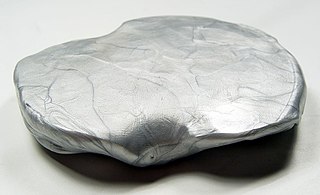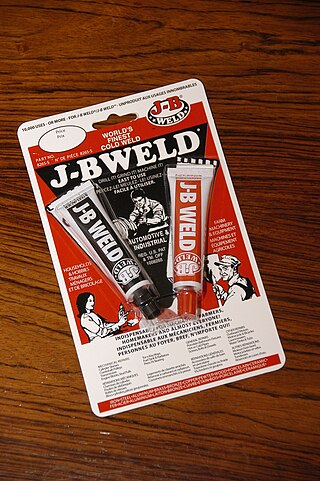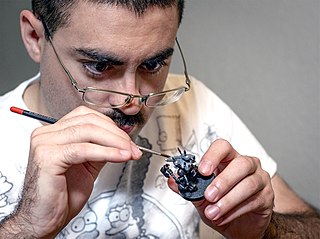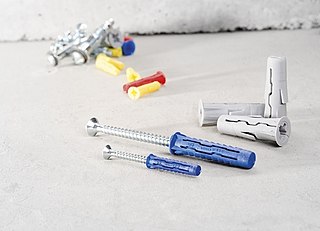
Silly Putty is a toy containing silicone polymers that have unusual physical properties. It can flow like a liquid, bounce and can be stretched or broken depending on the amount of physical stress to which it is subjected. It contains viscoelastic liquid silicones, a type of non-Newtonian fluid, which makes it act as a viscous liquid over a long period of time but as an elastic solid over a short time period. It was originally created during research into a potential rubber substitutes for use by the United States in World War II.

Epoxy is the family of basic components or cured end products of epoxy resins. Epoxy resins, also known as polyepoxides, are a class of reactive prepolymers and polymers which contain epoxide groups. The epoxide functional group is also collectively called epoxy. The IUPAC name for an epoxide group is an oxirane.

Plaster is a building material used for the protective or decorative coating of walls and ceilings and for moulding and casting decorative elements. In English, "plaster" usually means a material used for the interiors of buildings, while "render" commonly refers to external applications. The term stucco refers to plasterwork that is worked in some way to produce relief decoration, rather than flat surfaces.

Plasticine is a putty-like modelling material made from calcium salts, petroleum jelly and aliphatic acids. Though originally a brand name for the British version of the product, it is now applied generically in English as a product category to other formulations.

In industry, product lifecycle management (PLM) is the process of managing the entire lifecycle of a product from its inception through the engineering, design and manufacture, as well as the service and disposal of manufactured products. PLM integrates people, data, processes, and business systems and provides a product information backbone for companies and their extended enterprises.

Putty is a material with high plasticity, similar in texture to clay or dough, typically used in domestic construction and repair as a sealant or filler. Although some types of putty slowly polymerise and become stiff, many putties can be reworked indefinitely, in contrast to other types of filler which typically set solid relatively rapidly.

Polymer clay is a type of hardenable modeling clay based on the polymer polyvinyl chloride (PVC). It typically contains no clay minerals, but like mineral clay a liquid is added to dry particles until it achieves gel-like working properties. Similarly, the part is put into an oven to harden, hence its colloquial designation as clay. Polymer clay is generally used for making arts and craft items, and is also used in commercial applications to make decorative parts. Art made from polymer clay can now be found in major museums.

The J-B Weld Company is an international company that produces epoxy products. The home office is based in Sulphur Springs, Texas. J-B Weld is the name of their flagship product: a specialized, high-temperature epoxy adhesive for use in bonding materials together. The company has run advertisements showing engine block repair with J-B Weld.

In miniature wargaming, players enact simulated battles using scale models called miniature models, which can be anywhere from 2 to 54 mm in height, to represent warriors, vehicles, artillery, buildings, and terrain. These models are colloquially referred to as miniatures or minis.

Figure painting, or miniature painting, is the hobby of painting miniature figures and/or model figures, either as a standalone activity or as a part of another activity that uses models, such as role-playing games, wargames, or military modeling.

FANUC is a Japanese group of companies that provide automation products and services such as robotics and computer numerical control wireless systems. These companies are principally FANUC Corporation of Japan, Fanuc America Corporation of Rochester Hills, Michigan, USA, and FANUC Europe Corporation S.A. of Luxembourg.
Miniature conversion refers to the practice of altering the appearance of a miniature or model so as to deviate from the standard version purchased in a boxed set.
Bondo is a polyester putty product originally marketed as an automotive body filler. Nowadays the brand name is used by 3M for a line of American-made products for automotive, marine and household repairs. The term Bondo is trademarked by 3M, but is commonly used to refer to any brand of automotive repair putty due to its popularity. It is also used by sculptors.

Sculpey is the brand name for a type of polymer clay that can be molded and put into a conventional oven to harden, as opposed to typical modeling clays, which require a much hotter oven, such as a kiln. Until it is baked, Sculpey has a consistency somewhat like Plasticine. Its main competitor is the German brand Fimo. It is sold in many colors, but can also be painted once baked. Sculpey has become popular with modeling artists, jewellery makers, and other craft work.

Powder coating is a type of coating that is applied as a free-flowing, dry powder. Unlike conventional liquid paint, which is delivered via an evaporating solvent, powder coating is typically applied electrostatically and then cured under heat or with ultraviolet light. The powder may be a thermoplastic or a thermoset polymer. It is usually used to create a thick, tough finish that is more durable than conventional paint. Powder coating is mainly used for coating of metal objects, particularly those subject to rough use. Advancements in powder coating technology like UV-curable powder coatings allow for other materials such as plastics, composites, carbon fiber, and MDF to be powder coated, as little heat or oven dwell time is required to process them.

Plasterwork is construction or ornamentation done with plaster, such as a layer of plaster on an interior or exterior wall structure, or plaster decorative moldings on ceilings or walls. This is also sometimes called pargeting. The process of creating plasterwork, called plastering or rendering, has been used in building construction for centuries. For the art history of three-dimensional plaster, see stucco.

Lime mortar or torching is a masonry mortar composed of lime and an aggregate such as sand, mixed with water. It is one of the oldest known types of mortar, used in ancient Rome and Greece, when it largely replaced the clay and gypsum mortars common to ancient Egyptian construction.

A wall plug also known as an anchor (US) or "Rawlplug" (UK), is a fibre or plastic insert used to enable the attachment of a screw in material that is porous or brittle or that would otherwise not support the weight of the object attached with the screw. It is a type of anchor that, for example, allows screws to be fitted into masonry walls. In US English, mentions of drywall anchors are sometimes meant to refer specifically to the type of plastic wall plugs with expandable wings for hollow walls, in contradistinction with mollies and toggle bolts.

Epoxy putty refers to a group of room-temperature-hardening substances used as space-filling adhesives. Exact compositions vary according to manufacturer and application. They are stored until used as two components of clay-like consistency. Kneading the two components into each other creates an exothermic chemical reaction that activates the substance for use by catalysing an epoxide polymerisation reaction. Unlike many other types of glues, an epoxy adhesive can fill gaps, and even be moulded into a structural part. Some makers claim in advertising that one can drill and tap their cured products and that they quickly cure "hard as steel", though they are much weaker than steel in tensile strength and shear strength.
Akemi GmbH is a company in the chemical industry which is active worldwide. Its headquarters are in Nuremberg in Germany and its core competence is the manufacturing of two-component adhesive systems. The chemical-technical specialist factory manufactures adhesives, fillers as well as cleaning and care products for the natural stone sector. In addition, it produces fillers and repair materials, sealants, protective coatings, varnishes as well as cleaning and car care products for the automotive branch.
















